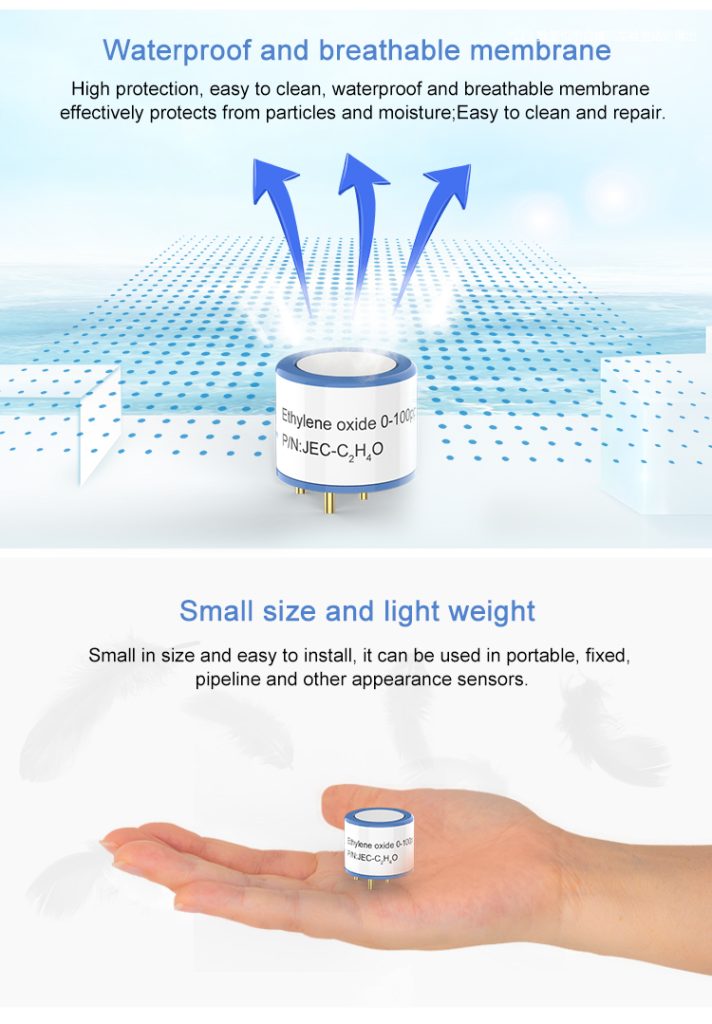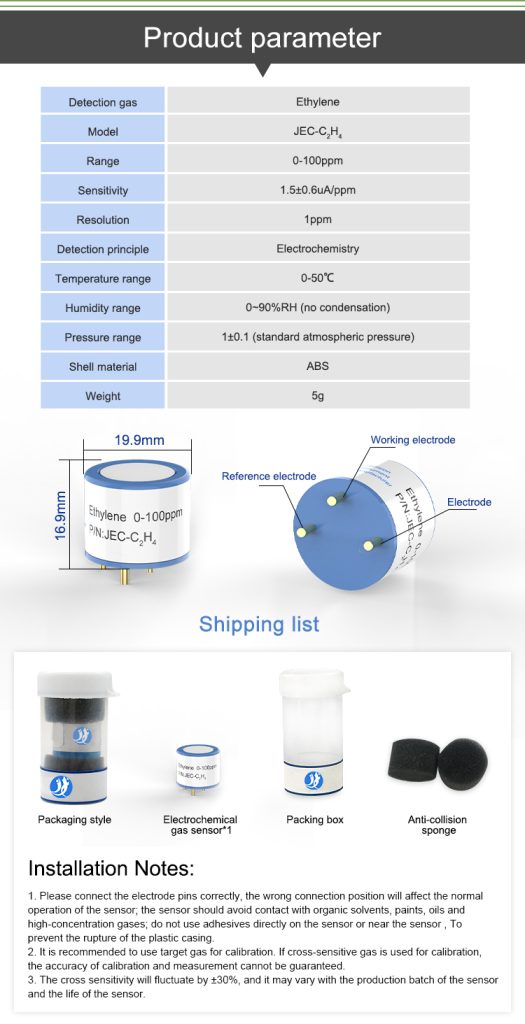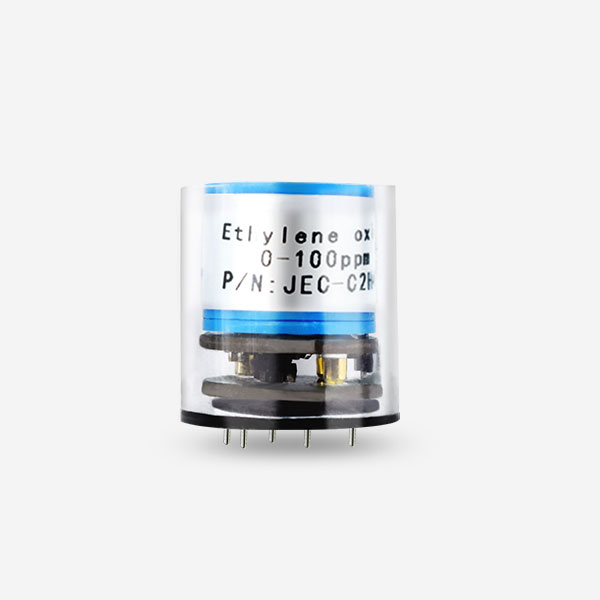Understanding ethylene gas
Ethylene is a crucial plant hormone and a naturally occurring gas that plays a significant role in the ripening, aging, and senescence of fruits, vegetables, and flowers. However, ethylene can also pose challenges in various industrial and agricultural settings, where its presence in excessive concentrations can lead to premature ripening, spoilage, and economic losses. To address these concerns, the development of advanced ethylene gas sensors has become increasingly important. This article explores the significance of ethylene gas detection, the limitations of traditional detection methods, and the emergence of innovative technologies for more accurate and efficient monitoring.
Ethylene electrochemical gas detection module – C2H4 gas sensor
Furthermore, in industrial settings, such as fruit and vegetable processing facilities, ethylene monitoring is crucial for optimizing production processes, maintaining product quality, and minimizing waste. Timely detection of ethylene leaks or buildup can prevent premature ripening and spoilage, ensuring the efficient utilization of resources and reducing economic losses.
The strong development of ethylene gas sensors for these limitations provides a more reliable and sensitive monitoring solution.
Emerging Technologies for Ethylene Gas Detection
Photoacoustic Spectroscopy: Photoacoustic spectroscopy is an advanced technique that has shown promise in ethylene gas detection. This method relies on the absorption of modulated light by ethylene molecules, leading to the generation of an acoustic signal that can be quantitatively analyzed. Photoacoustic ethylene sensors offer high sensitivity, selectivity, and real-time monitoring capabilities, making them suitable for a wide range of applications, including fruit storage facilities, transportation containers, and industrial processing plants.

Non-Dispersive Infrared (NDIR) Sensors: NDIR sensors are based on the principle of measuring the absorption of infrared light by ethylene molecules. These sensors offer high sensitivity and selectivity, allowing for accurate detection of ethylene at low concentrations. NDIR technology is well-suited for continuous monitoring in industrial environments, where the early detection of ethylene leaks or emissions is critical for maintaining product quality and safety.
Laser-Based Absorption Spectroscopy: Laser-based absorption spectroscopy techniques, such as tunable diode laser absorption spectroscopy (TDLAS), enable precise and selective detection of ethylene gas. By utilizing specific wavelengths of laser light that correspond to ethylene’s absorption spectrum, these sensors can provide highly accurate and real-time measurements. Laser-based ethylene sensors are particularly valuable in applications where rapid response times and high sensitivity are essential, such as in controlled atmosphere storage facilities and fruit ripening chambers.
Metal-Oxide Semiconductor (MOS) Gas Sensors: MOS sensors are a type of solid-state gas sensor that has been explored for ethylene detection. These sensors operate by measuring the changes in electrical conductivity of metal-oxide films in the presence of ethylene gas. MOS sensors offer the advantages of low cost, miniaturization, and potential integration into wireless sensor networks for distributed monitoring applications.

Advantages of Ethylene Sensors
The emergence of advanced ethylene gas sensors brings several advantages over traditional detection methods, including:

High Sensitivity: Advanced sensors offer enhanced sensitivity, enabling the detection of ethylene at low concentrations, which is critical for early intervention and preventive measures in agricultural and industrial settings.
Selectivity: Many advanced sensors exhibit high selectivity for ethylene, minimizing the potential for false readings and cross-sensitivity to other gases commonly present in the environment.
Real-Time Monitoring: The real-time monitoring capabilities of advanced ethylene sensors allow for immediate detection and response to changes in ethylene levels, facilitating proactive management of fruit ripening, storage conditions, and industrial processes.
Portability and Integration: Some advanced sensors are designed for portability and integration into wireless sensor networks, enabling on-site, distributed monitoring in diverse applications, including transportation, horticulture, and industrial facilities.
Reduced Maintenance: Advanced sensors often require minimal maintenance and calibration, contributing to their cost-effectiveness and practicality for long-term deployment in various environments.
Applications of Ethylene Gas Sensors
The development of advanced ethylene gas sensors has opened up new possibilities for their utilization in a wide range of applications, including:
Post-Harvest Management: Advanced ethylene sensors are valuable for monitoring ethylene levels in fruit and vegetable storage facilities, cold storage warehouses, and transportation containers. By maintaining optimal ethylene concentrations, producers and distributors can extend the shelf life of perishable goods and reduce spoilage.
Controlled Atmosphere Storage: Ethylene sensors play a crucial role in controlled atmosphere storage facilities, where the precise regulation of ethylene levels is essential for preserving the quality and freshness of stored produce, such as apples, pears, and kiwifruit.
Fruit Ripening Facilities: Ethylene monitoring is integral to fruit ripening processes in commercial facilities. Advanced sensors enable precise control of ethylene exposure, ensuring uniform ripening and minimizing the risk of overripening or spoilage.
Horticulture and Floriculture: Advanced ethylene sensors are used in greenhouses, floral shops, and nurseries to protect ethylene-sensitive plants from premature aging and damage. Monitoring ethylene levels helps maintain the quality and marketability of flowers and ornamental plants.
Industrial Processes: Ethylene sensors are employed in industrial settings, such as food processing plants, to monitor ethylene emissions, detect leaks, and optimize production processes. Real-time monitoring facilitates the early detection of ethylene-related issues, contributing to improved product quality and operational efficiency.
Research and Development: Advanced ethylene gas sensors are utilized in research laboratories and academic institutions for studying plant physiology, post-harvest biology, and the effects of ethylene on plant development. These sensors provide valuable tools for conducting controlled experiments and investigating ethylene-related phenomena.
Conclusion
The development of advanced ethylene gas sensors represents a significant advancement in the field of gas detection and monitoring. By offering high sensitivity, selectivity, and real-time capabilities, these sensors address the limitations of traditional detection methods and open up new opportunities for applications in agriculture, horticulture, food storage, and industrial processes. As the demand for accurate and efficient ethylene monitoring continues to grow, the ongoing innovation and integration of advanced sensor technologies will play a pivotal role in enhancing product quality, reducing waste, and supporting sustainable practices across various industries.
